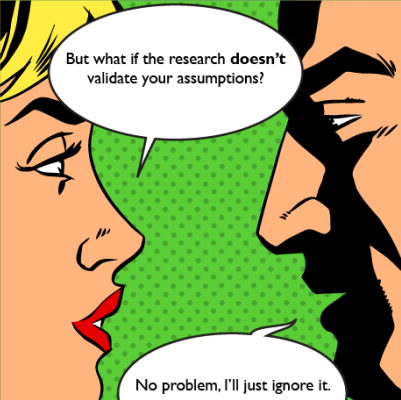
Bob had a great product idea. Shoes made out of broken glass.
He thought this would appeal to environmentally conscious people who wanted to make use of all the sharp shards of broken glass out there in the world.
Bob decided to do some market research to validate his idea so he asked some of his friends “Hey, would you buy shoes made out of broken glass?”
The answer came back loud and clear. “Hell no, that’s a crazy idea!”
That didn’t really deter Bob, because he decided that his friends are probably not his target market. So he went to a recycling conference and asked some people there. Same answer “Uh, no… recycling is good but that’s not a great use of broken glass”.
Still Bob was unfazed. He had a cheap supply of broken glass ready to go, and he had developed a great manufacturing process to create the shoes from it. He figured that this was a great business model because he could get the raw materials for practically free! Not to mention, he had a great logo design already developed.
Some late night googling revealed videos of various people walking on broken glass . “Aha!” he thought, “That’s who I need to talk to.” He asked them the same question and this time the response was “Oh yeah, I might try that – maybe”.
Boom! There was his market validation, and he got right to work producing shoes out of broken glass.
Poor Bob.
You may have gathered that Bob and his broken glass shoes don’t really exist. But I’m sure you know, (as I do) lots of entrepreneurs who should take their idea behind the barn and shoot it. TV shows such as Shark Tank are full of people like this.
This happens at big companies as well, but it can be much more insidious because groupthink can set in so that everyone lives in a self-congratulatory echo chamber. Big companies also have much greater resources to put towards research. However, if their mindset is not open to acting on the results, the effort and investment is wasted.
It is always a red flag to me when someone says that the purpose of the research is to “validate our assumptions”. It indicates that they have already come to a conclusion and they are only looking for corroborating evidence. Any evidence that contradicts what they already think will be ignored. That’s too bad because they are missing huge opportunities to learn about their customers and the market.
After one large research project, a client said to me “I’m not asking you to lie, but it would be great if your report could align with the assumptions we had going in”.
He didn’t ask this because he was a bad or deceptive person. It was because he viewed the research as a checkmark on his list of to-dos, rather than actually informing the product decisions. He wanted to do the research, file the report, and proceed according to plan. The notion that customer feedback could affect the plan did not occur to him. This is all too common and is usually a sign that the organization views their role as serving the product, rather than serving the customer.
Doing customer research is great. But ask yourself: are you using the research to help you make product decisions, or to confirm what you already believe?
Image credit: ShutterStock | StudioStoks



